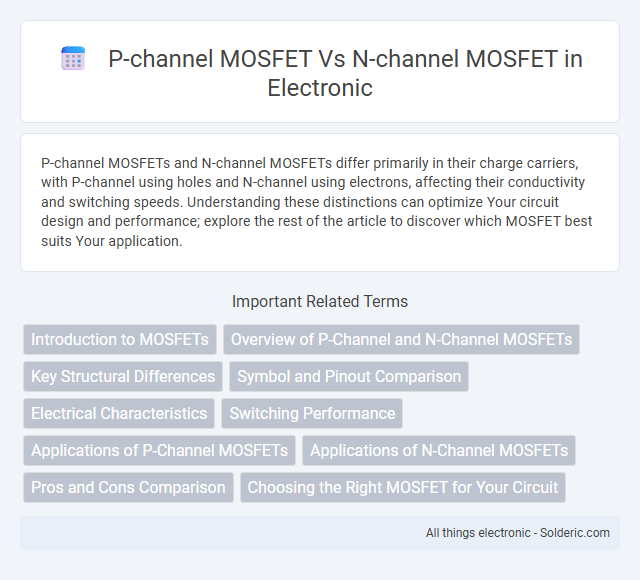P-channel MOSFETs and N-channel MOSFETs differ primarily in their charge carriers, with P-channel using holes and N-channel using electrons, affecting their conductivity and switching speeds. Understanding these distinctions can optimize Your circuit design and performance; explore the rest of the article to discover which MOSFET best suits Your application.
Comparison Table
| Feature | P-Channel MOSFET | N-Channel MOSFET |
|---|---|---|
| Type | P-type semiconductor | N-type semiconductor |
| Charge Carriers | Holes | Electrons |
| Symbol | Arrow points inwards (source to gate) | Arrow points outwards (source to gate) |
| Threshold Voltage (Vth) | Typically negative | Typically positive |
| Switching Speed | Slower | Faster |
| On-resistance (RDS(on)) | Higher | Lower |
| Usage | High-side switching | Low-side switching |
| Driving Voltage | Gate voltage must be lower than source | Gate voltage must be higher than source |
| Applications | Power management, load switching | Switch mode power supplies, motor control |
Introduction to MOSFETs
P-channel and N-channel MOSFETs are types of metal-oxide-semiconductor field-effect transistors used for switching and amplification in electronic circuits. N-channel MOSFETs typically offer higher electron mobility and lower on-resistance compared to P-channel MOSFETs, making them more efficient for high-speed and high-current applications. P-channel MOSFETs, controlled by negative gate voltage relative to the source, are often preferred for high-side switching due to their simpler gate drive requirements in certain circuit topologies.
Overview of P-Channel and N-Channel MOSFETs
P-Channel and N-Channel MOSFETs are essential components in electronic circuits, with N-Channel types typically offering higher electron mobility and greater efficiency in switching applications. P-Channel MOSFETs conduct when a negative voltage is applied to the gate, making them suitable for high-side switching, while N-Channel MOSFETs require a positive gate voltage and are commonly used for low-side switching due to their lower on-resistance. Choosing the right MOSFET for your design depends on factors like voltage polarity, switching speed, and efficiency requirements.
Key Structural Differences
P-channel MOSFETs utilize p-type material for the channel and source/drain regions, allowing holes to conduct current, whereas N-channel MOSFETs use n-type material with electrons as the primary charge carriers. The gate voltage polarity required for conduction differs: P-channel devices turn on with a negative gate-to-source voltage, while N-channel devices require a positive voltage. Structurally, N-channel MOSFETs generally exhibit higher electron mobility, leading to better conductivity and faster switching compared to P-channel MOSFETs.
Symbol and Pinout Comparison
P-channel MOSFETs feature a symbol with an arrow pointing inward toward the gate, while N-channel MOSFETs display an arrow pointing outward from the gate, indicating the direction of conventional current flow. The pinout for both typically includes the gate, drain, and source terminals but their polarity and connection differ, with P-channel devices requiring a negative gate voltage relative to the source for activation. Understanding these symbol and pinout distinctions helps you correctly integrate MOSFETs in circuit designs, ensuring proper functionality and reliability.
Electrical Characteristics
P-channel MOSFETs generally have lower electron mobility than N-channel MOSFETs, resulting in higher on-resistance and slower switching speeds. N-channel MOSFETs exhibit better conductivity and efficiency due to electrons being the majority carriers, which enhances your circuit's performance in high-speed and low-loss applications. Voltage polarity and gate drive requirements also differ, with P-channel devices requiring negative gate voltages relative to the source for activation, affecting design considerations.
Switching Performance
P-channel MOSFETs generally have slower switching speeds compared to N-channel MOSFETs due to lower electron mobility in the p-type substrate. N-channel MOSFETs offer faster switching performance, higher efficiency, and lower on-resistance, making them more suitable for high-speed applications. Your choice of transistor can significantly impact the overall switching efficiency and thermal performance in your design.
Applications of P-Channel MOSFETs
P-Channel MOSFETs are primarily used in high-side switch applications where controlling the positive voltage supply is essential, such as power management in battery-powered devices and load switching circuits. Their ability to simplify gate drive requirements in positive voltage rail configurations makes them ideal for power distribution and reverse polarity protection. Your design benefits from P-Channel MOSFETs in scenarios requiring efficient and straightforward switching on the high side of a load.
Applications of N-Channel MOSFETs
N-channel MOSFETs are widely used in power management, switching regulators, and load switching due to their low on-resistance and high electron mobility, enabling efficient current conduction. They are preferred in high-speed switching applications such as DC-DC converters and motor drivers because of faster switching times compared to P-channel MOSFETs. Your electronic circuits benefit from N-channel MOSFETs when requiring robust performance in low-voltage, high-current environments.
Pros and Cons Comparison
P-channel MOSFETs offer simpler high-side switching and easier gate drive requirements but typically exhibit higher on-resistance and slower switching speeds compared to N-channel MOSFETs. N-channel MOSFETs provide lower on-resistance, faster switching, and better efficiency, making them ideal for low-voltage and high-current applications. However, they require more complex gate drive circuitry for high-side configurations, limiting their ease of use in certain designs.
Choosing the Right MOSFET for Your Circuit
Selecting between a P-channel MOSFET and an N-channel MOSFET depends on your circuit's switching requirements and voltage polarity. N-channel MOSFETs typically offer lower on-resistance and higher efficiency, making them ideal for low-side switching, while P-channel MOSFETs simplify high-side switching despite higher conduction losses. Evaluating parameters like gate drive voltage, load current, and switching speed will help you choose the optimal MOSFET for your design.
P-channel MOSFET vs N-channel MOSFET Infographic

 solderic.com
solderic.com